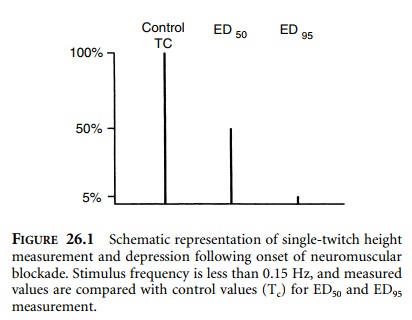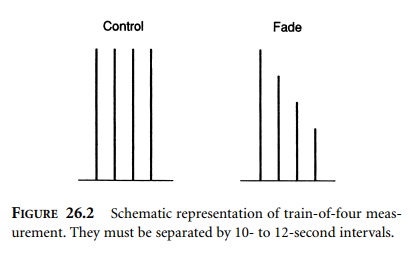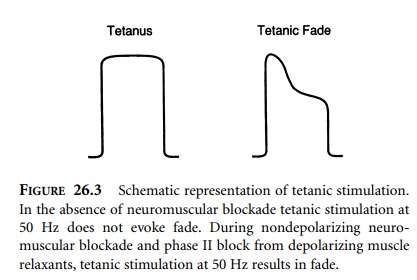Chapter: Clinical Cases in Anesthesia : Monitoring the Neuromuscular Junction
Explain the different patterns of nerve stimulation and the relevance of pattern choice
Explain
the different patterns of nerve stimulation and the relevance of pattern
choice.
The simplest pattern is single-twitch
stimulation (Figure 26.1). The stimulus should be a rectangular pulse of
0.1–0.3 millisecond duration. Stimulus frequencies of greater than 0.15 Hz may
cause fade in single-twitch meas-urements; therefore, measurements are
generally made at 0.1 Hz intervals. A supramaximal stimulus is required. A
control (pre-neuromuscular blockade) single twitch (Tc) is measured
and recorded. Subsequent single-twitch meas-urements are compared with the
control value (T1/Tc). This mode is primarily useful in
research. Relative poten-cies of neuromuscular blocking agents are measured,
and recovery rates are quantified. Single-twitch stimulation has its
limitations. It requires recording of control values before administration of
neuromuscular blockers. In addi-tion, full return of single-twitch height to
control levels does not guarantee normal function of the neuromuscular
junction.

A clinically useful stimulation pattern (Figure
26.2) is the train-of-four (TOF). When a peripheral nerve is stimulated at a
rate greater than 0.15 Hz, the muscular response will

The ratio of the fourth to the first
twitch is measured (T4/T1), and called the T4
ratio. Four stimuli applied at a frequency of 2 Hz are employed clinically.
Multiple TOF stimuli are separated by 10- to 12-second intervals to ensure
maximal twitch height. Fade on the TOF is a property of nondepolarizing muscle
relaxants. It is a presynaptic phenomenon. Depolarizing muscle relaxants do not
show fade on TOF unless a phase II block has occurred. An advantage of TOF
monitoring compared with single-twitch monitoring is that a recorded control
value is not required.
Furthermore, fade of the fourth twitch is still
seen when the first twitch has fully recovered, making TOF measure-ments a more
sensitive indicator of neuromuscular block-ade than single-twitch measurements.
A T4 ratio of greater than 0.7 on MMG or 0.9 on EMG correlates well
with clinical signs of recovery from nondepolarizing neuromus-cular blockade.
When TOF is measured by manual palpation or observation, as in most clinical
situations, the degree of fade is generally underestimated. Therefore, the
trachea should not be extubated when fade is visible or palpable.
The fourth twitch disappears completely when
the first twitch height is 25% of control. This usually correlates well with
adequate surgical relaxation. Disappearance of the third twitch occurs when the
first twitch is 80% depressed, and at 90% first twitch height depression, the
second twitch disappears. This is the degree of relaxation required to
facilitate endotracheal intubation.
High-frequency (30–200 Hz) nerve stimulation is
called tetanic stimulation and evokes a tetanic response without fade in the
unrelaxed muscle (Figure 26.3). Physiologic frequencies of 50 Hz are most
commonly employed in the operating room. Higher frequencies may produce fade
even in the absence of neuromuscular blockade and are, therefore, overly
sensitive for clinical situations. At a stimulus frequency of 50 Hz, tetanic
fade is seen only in the presence of nondepolarizing or phase II neuromuscular
blockade. As previously alluded to, fade is felt to be a presynaptic phenomenon
resulting from a decrease in presynaptic acetylcholine stores in the presence
of a postsynaptic com-petitive blockade of acetylcholine receptors. Blockade of
presynaptic acetylcholine receptors may play a role as well. A sustained
response to a 50 Hz tetanic stimulus correlates very well with the ability to
protect the airway.

Application of a tetanic stimulus elicits a
phenomenon called post-tetanic
facilitation. Following tetanic stimula-tion, responses to single-twitch or
TOF stimulation are aug-mented. Tetanic stimulation at 50 Hz applied for 5
seconds requires a 2-minute recovery period to avoid post-tetanic facilitation.
Care must therefore be taken not to apply a tetanic stimulus shortly before a
TOF stimulus. When profound neuromuscular blockade is present and the TOF
completely obliterated, the presence of TOF response following tetanic
stimulation (post-tetanic facilitation) portends the return of TOF and eventual
reversibility.
Another modality is double-burst stimulation.
Two brief (0.2 milliseconds) tetanic stimuli are separated by 750 milliseconds.
Consecutive double-burst stimulations must be separated by at least 15 seconds.
Two palpable twitches are elicited. These twitches may exhibit fade, which
correlates well with fade on the TOF. As previously mentioned, absence of
palpable or visible fade on standard TOF monitoring may be associated with
residual, measur-able fade on TOF by MMG or EMG. The presence of two equivalent
twitches following double-burst stimulation accurately indicates the absence of
neuromuscular blockade and more sensitively indicates return of neuromuscular
function than tetanus or TOF.
Related Topics